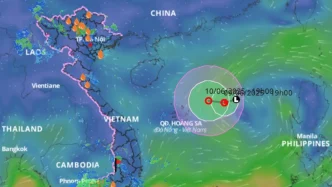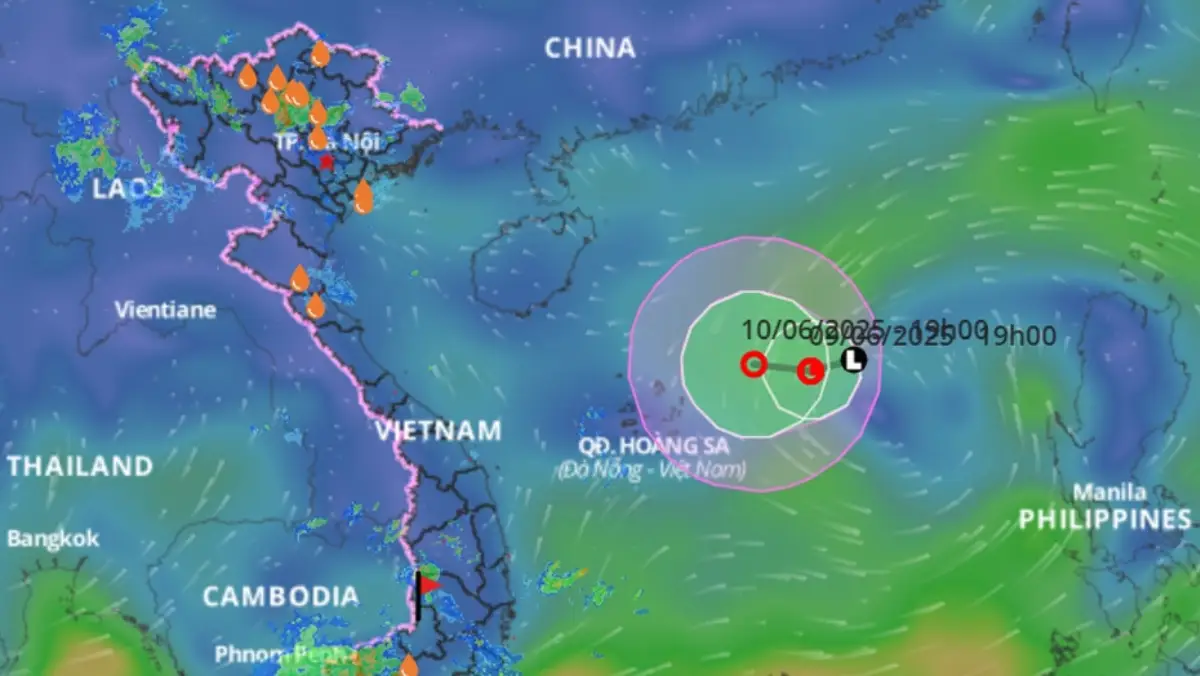A tropical depression forming in the upper South China Sea has sparked attention across Southeast Asia, with weather authorities monitoring its slow but potentially disruptive path. The Thailand Meteorological Department (TMD) issued a warning on June 11, 2025, detailing the system’s intensification from a low-pressure area into a tropical depression, currently positioned at 15.0°N latitude and 114.5°E longitude. While the storm is not expected to directly impact Thailand, its trajectory toward Hainan Island and southern China raises broader regional concerns about weather patterns and preparedness in the wake of recent typhoons.
Tracking the Storm’s Development
According to the TMD’s first announcement on the matter, released as No. 1 (135/2568), the tropical depression emerged at 7:00 a.m. on June 10, 2025. By 10:00 a.m. that day, the storm’s center was recorded with maximum wind speeds of around 55 kilometers per hour. Moving west-northwest at a sluggish pace, the system is anticipated to escalate into a tropical storm within the next few days. Its projected path will likely see it traverse Hainan Island, China’s southernmost province, between June 13 and 14, before weakening as it moves inland and eventually dissipating.
The TMD has emphasized that Thailand is unlikely to face direct effects from this particular weather system. However, the department continues to monitor the situation, noting that indirect impacts—such as altered monsoon patterns or increased rainfall—could still influence local weather in the coming weeks. Residents and authorities in coastal and low-lying areas remain on alert, drawing from experiences with past storms that have caused significant disruption across the region.
Regional Implications and Memories of Typhoon Yagi
The formation of this tropical depression comes less than a year after Super Typhoon Yagi, which barreled through parts of Southeast Asia in September 2024, leaving a trail of destruction before heading toward Hainan. Images from that period, such as a woman walking her dogs on a beach on Lantau Island in Hong Kong as the typhoon approached, underscored the eerie calm before the storm for many communities. While the current depression is not yet on the same scale as Yagi, its emergence in a similar area of the South China Sea has prompted comparisons and heightened vigilance.
In Vietnam, which often bears the brunt of typhoons and tropical storms originating in the South China Sea, authorities are closely watching the situation. The country’s northern and central regions, including cities like Ha Noi and Da Nang, have faced devastating floods and landslides from past weather events. Although the current storm’s path points toward China, a slight shift in trajectory could bring it closer to Vietnam’s coast, prompting early preparations. “We are always ready to respond if the situation changes” said a spokesperson for Vietnam’s National Center for Hydro-Meteorological Forecasting.
Meanwhile, in southern China, particularly Hainan Island, the memory of Typhoon Yagi’s impact looms large. The island province, a popular tourist destination, often faces economic losses from storm-related disruptions. Local officials are reportedly ramping up efforts to secure infrastructure and warn residents as the depression approaches, though no official statements have been released at the time of writing.
Climate Patterns and Broader Concerns
The intensification of this tropical depression aligns with broader climatic trends in the region, where the frequency and severity of storms have raised questions about climate change’s role. Experts note that warmer sea surface temperatures in the South China Sea can fuel the rapid development of low-pressure systems into more dangerous storms. While it remains speculative whether this particular depression will escalate significantly, the potential for such transformations underscores the need for robust regional cooperation on weather monitoring and disaster response.
In Thailand, even without direct impact, the TMD’s warning serves as a reminder of the interconnected nature of weather systems in Southeast Asia. The country’s coastal tourism hubs, such as Phuket and Pattaya, rely heavily on stable weather for their economies. A representative from the Tourism Authority of Thailand noted, “Even indirect effects like heavier rains or rough seas can affect visitor confidence” highlighting the ripple effects of such weather phenomena.
Further afield, countries like the Philippines, which often lie in the path of typhoons forming in the South China Sea, are also keeping a close eye on developments. Although the current forecast suggests the storm will bypass the archipelago, Manila’s weather bureau has issued preliminary advisories to fishermen and coastal communities to remain cautious.
Community Preparedness and Lessons Learned
For many in the region, the annual cycle of tropical storms and typhoons is a familiar challenge, but one that demands constant adaptation. In rural areas of Thailand and Vietnam, communities have developed local strategies to cope with sudden weather shifts, from reinforcing homes to stockpiling essentials. Urban centers, however, often face greater risks due to dense populations and infrastructure vulnerabilities. Flooding in cities like Bangkok and Ho Chi Minh City during past storms has exposed gaps in drainage systems and emergency planning, issues that remain unresolved in many areas.
International aid organizations and regional bodies, such as the ASEAN Coordinating Centre for Humanitarian Assistance on Disaster Management, are also on standby. Their role becomes critical if the storm veers off its predicted course or intensifies unexpectedly. Past events, including Typhoon Yagi, demonstrated the importance of swift cross-border coordination in delivering relief and rebuilding efforts.
Looking Ahead
As the tropical depression inches closer to Hainan Island, the next few days will be crucial in determining its ultimate impact. Weather models suggest a weakening after landfall in southern China, but the unpredictability of such systems means that vigilance remains essential. For now, Southeast Asia watches and waits, drawing on past experiences to brace for whatever this latest weather event may bring. In a region accustomed to nature’s unpredictability, the question lingers: will this be a minor disturbance, or a harbinger of more turbulent times ahead?
















